Rapid Drug Screening Explained: How Fast and Accurate Testing Enhances Workplace Safety

Introduction to Rapid Drug Screening: What Is Rapid Drug Screening?
Rapid drug screening refers to the process of quickly detecting the presence of drugs in an individual’s system using specialized test kits. These tests are designed to provide fast results, often within minutes, making them ideal for situations where immediate decisions are necessary. Unlike traditional drug testing methods, which may require laboratory processing and several days for results, rapid drug screening offers on-the-spot testing that can be crucial in various industries such as employment, healthcare, and law enforcement.
Rapid drug screening typically uses a variety of methods to detect specific substances, such as urine, saliva, hair, and blood tests. These tests are frequently used to assess whether an individual has recently used drugs and can help identify patterns of substance abuse. With their quick turnaround time and ease of use, rapid drug tests have become increasingly popular in workplace settings, healthcare environments, and legal proceedings.
The Significance of Rapid Drug Screening in Various Industries
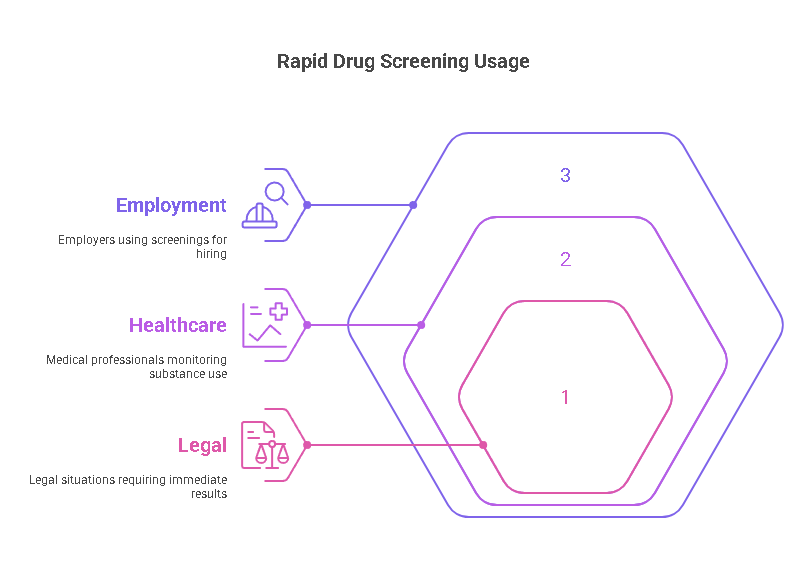
- Employment: Employers are increasingly using rapid drug screenings as part of their hiring process or for routine employee testing. These screenings help employers ensure a drug-free workplace, maintain employee safety, and meet compliance regulations. Rapid drug tests are often used to assess pre-employment applicants, employees in safety-sensitive positions, and individuals who may be returning to work after a period of absence.
- Healthcare: In healthcare settings, rapid drug testing is vital for diagnosing and monitoring substance use disorders. Medical professionals rely on these tests to assess a patient’s condition, make informed decisions about treatment options, and ensure that prescribed medications are being taken properly. For example, doctors might use rapid screenings to detect opioid abuse or to verify that patients are adhering to pain management programs.
- Legal: Rapid drug testing is often employed in legal situations, including probation or parole monitoring, child custody cases, and drug-related offenses. These tests provide immediate results that can be used as evidence in court to determine if an individual is in violation of their legal obligations. Additionally, law enforcement agencies use rapid drug tests in roadside checks or for suspected impaired driving.
Types of Rapid Drug Tests Available
Various types of rapid drug tests are available, each designed to detect specific substances. The most common types of rapid drug screening include urine, saliva, hair, and blood tests. Each method has its own advantages and limitations, depending on the context in which the test is being used.
- Urine Testing: Urine is one of the most commonly used samples for drug screening because it is easy to collect and is capable of detecting a wide range of substances. Urine tests can detect recent drug use and are capable of testing for drugs such as marijuana, cocaine, amphetamines, opiates, and PCP.
- Saliva Testing: Saliva drug tests are non-invasive and easy to administer. These tests detect the presence of drugs in an individual’s mouth and can provide results within minutes. Saliva testing is commonly used for detecting recent drug use and is often employed in roadside sobriety checks or workplace testing for substances like marijuana and cocaine.
- Hair Testing: Hair drug testing provides a longer window for detecting drug use compared to urine or saliva testing. Hair follicles can retain traces of drugs for weeks or even months, making this an effective method for identifying past drug use. However, hair tests may not be as effective in detecting recent drug use.
- Blood Testing: Blood tests are the most accurate method for detecting the presence of drugs in the system, especially for substances such as alcohol or drugs that are actively impairing an individual’s ability to function. While more invasive than other methods, blood testing is often used in medical or legal settings where accurate detection is essential.
Rapid Drug Screening vs. Traditional Drug Testing
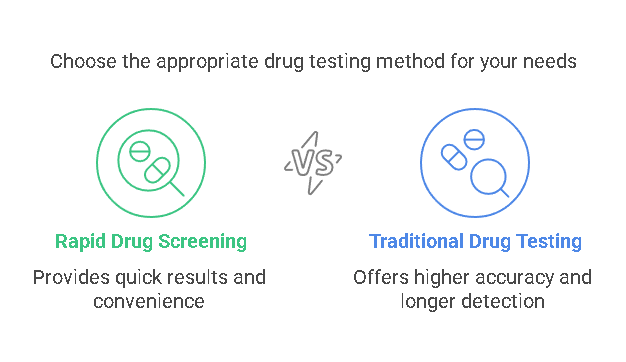
When compared to traditional drug testing methods, rapid drug screenings offer a number of advantages, though they also come with certain trade-offs in terms of accuracy and detection time.
- Speed: One of the most significant advantages of rapid drug screening is the speed at which results are provided. In contrast to traditional drug testing methods that may require several days to process in a laboratory, rapid drug tests provide results in minutes, allowing employers, healthcare professionals, and law enforcement agencies to make timely decisions.
- Convenience: Rapid drug tests are generally easier to administer and do not require specialized equipment or lab facilities. The tests can be conducted on-site, making them convenient for a variety of settings, including workplaces and healthcare facilities.
- Cost: Rapid drug tests are typically more affordable than traditional laboratory-based tests. The reduced cost of testing makes them an attractive option for employers and individuals seeking a more economical solution for drug screening.
- Accuracy: While rapid drug tests offer speed and convenience, their accuracy may not be as high as that of traditional drug tests. Rapid tests are designed for initial screening and may yield false positives or false negatives. In cases of inconclusive results, confirmation via traditional laboratory testing may be required to ensure the accuracy of the results.
- Detection Window: Traditional drug tests, particularly blood tests or hair follicle tests, can often detect drugs for longer periods, allowing for the identification of long-term or chronic use. However, rapid tests typically have a shorter detection window and are better suited for identifying recent or acute use of drugs.
Benefits of Using Rapid Drug Screening
The use of rapid drug screening offers several key benefits for employers, healthcare providers, and individuals:
- Immediate Results: Rapid drug tests provide quick results, allowing decision-makers to act swiftly. This is particularly valuable in situations where immediate action is required, such as in workplace safety or legal matters.
- Workplace Safety: In safety-sensitive environments, such as construction or transportation, rapid drug screening helps ensure that employees are not under the influence of drugs while performing their duties. This reduces the risk of workplace accidents and promotes a safer working environment.
- Legal Compliance: Many industries are subject to regulations that mandate drug testing for employees. Rapid drug screening helps businesses comply with these laws while maintaining a drug-free workplace. In addition, rapid testing can ensure that individuals are not engaging in substance abuse, reducing the risk of legal liabilities for employers.
- Cost-Effectiveness: Rapid drug screening is generally more affordable than traditional laboratory tests. This makes it a viable option for routine screenings or for businesses with large numbers of employees. The cost savings associated with rapid testing can be especially important for companies that need to screen employees regularly.
- Ease of Use: Rapid drug tests are user-friendly and require minimal training to administer. This makes them ideal for businesses or organizations that need to perform drug screenings frequently but do not have the resources to train staff on complex testing procedures.
The Role of Rapid Drug Screening in Ensuring Workplace Safety and Legal Compliance
Workplace safety is a critical concern for many employers, especially in industries with high-risk environments. Drug and alcohol use can impair an employee’s judgment, coordination, and reaction time, leading to accidents, injuries, or even fatalities. Rapid drug screening helps prevent these risks by identifying employees who may be under the influence while on the job.
In addition to ensuring safety, rapid drug screening plays a vital role in maintaining legal compliance with workplace regulations. For example, businesses in certain sectors are required to implement random drug testing or drug-free policies. Rapid drug testing ensures that these requirements are met, reducing the potential for legal issues or fines.
Moreover, by providing immediate results, rapid drug screening helps employers make timely decisions regarding an employee’s fitness for duty, ensuring that drug use does not interfere with workplace productivity and safety.
Why Quick Results Are Important in Drug Screening
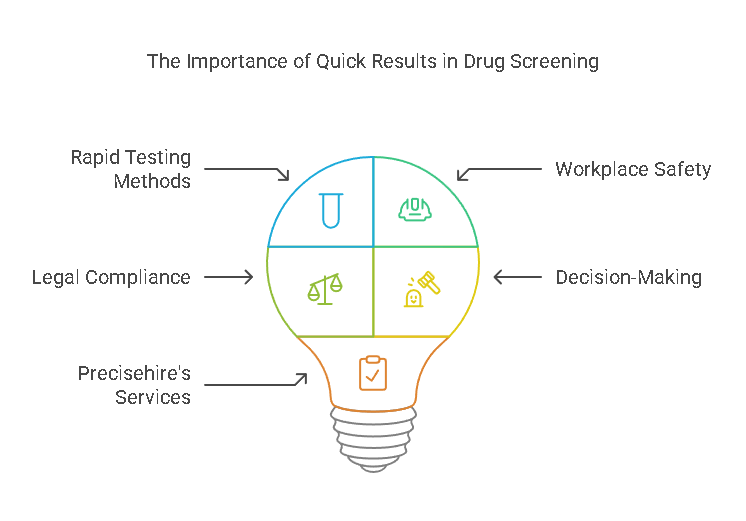
The speed at which drug screening results are provided is one of the most significant advantages of using rapid testing methods. In high-stakes environments, such as workplaces or law enforcement settings, decision-makers need immediate access to drug test results in order to take appropriate action. This can include determining whether an employee is fit to work, verifying compliance with legal regulations, or making decisions related to probation or parole cases.
Rapid drug screening provides a fast, cost-effective, and reliable method for detecting drug use. By offering immediate results, rapid drug tests contribute to making informed decisions, maintaining workplace safety, and ensuring compliance with legal and regulatory requirements.
We will explore how rapid drug screening is implemented in various settings, including workplaces, healthcare facilities, and law enforcement, as well as the challenges associated with its use. We will also discuss Precisehire’s services and how they can assist businesses with their drug testing needs
Implementing Rapid Drug Screening in Various Settings
Rapid drug screening is increasingly being adopted in a variety of settings, including workplaces, healthcare facilities, and law enforcement. Each of these environments presents unique challenges and considerations, but the ability to obtain quick results is universally valued. This section will explore how rapid drug screening is implemented across these different settings, the process for performing these tests, and the challenges that may arise.
Workplace Implementation of Rapid Drug Screening
In the workplace, rapid drug screening is essential for maintaining a safe and productive environment. Many businesses, especially those in industries that involve high-risk tasks or require safety-sensitive roles (such as transportation, construction, or manufacturing), use drug tests to ensure that employees are not under the influence while working. Pre-employment screenings, random testing, and post-incident tests are common practices in these environments.
Steps in Performing a Workplace Drug Test
- Test Preparation: The first step is to determine which method of testing will be used (e.g., urine, saliva, or breathalyzer test). The test kits are pre-packaged, typically containing the required supplies, such as collection containers or swabs, and instructions for use.
- Administering the Test: The test is administered to the employee in a designated area to maintain privacy. Depending on the type of test, the employee will either provide a urine sample, a saliva swab, or participate in a breath test. For urine tests, the employee provides the sample in a restroom or private room.
- Interpreting Results: The rapid drug test kit will show the results, usually in the form of a color change or lines indicating the presence of drugs. In the case of a positive result, a confirmation test (usually lab-based) may be required to verify the findings.
- Follow-Up Action: Employers must act on the results by either clearing the employee to work or taking appropriate disciplinary action if the test comes back positive. For instance, an employee with a positive result may be suspended from work pending further investigation or may be required to enter a substance abuse program.
Benefits for Employers
- Prevents Accidents: Ensures that employees are not impaired, reducing the likelihood of workplace accidents.
- Regulatory Compliance: Helps employers adhere to industry-specific regulations that mandate drug-free workplaces.
- Quick Action: The fast results allow employers to take timely action to maintain safety and productivity.
Healthcare Facility Implementation of Rapid Drug Screening
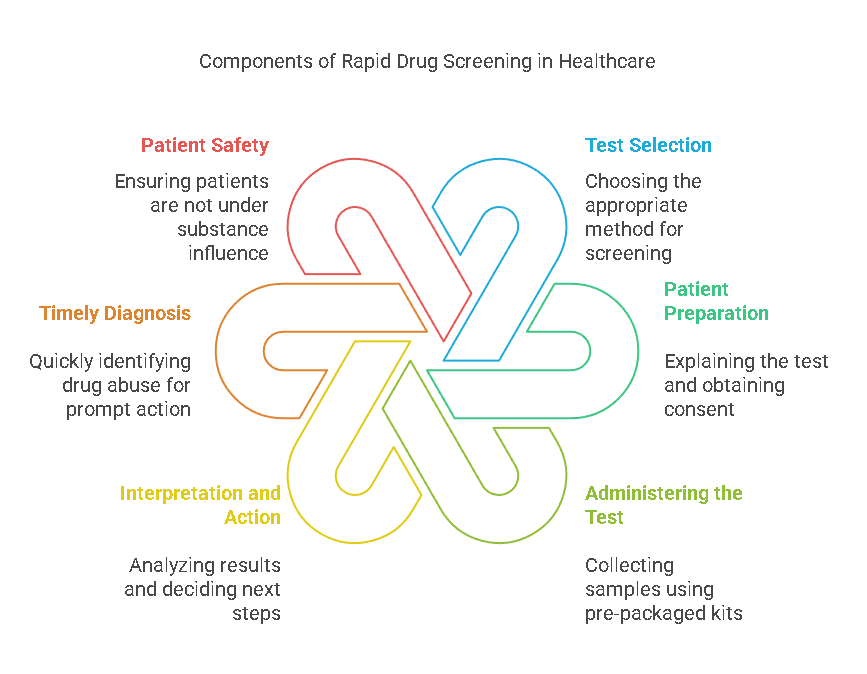
In healthcare settings, rapid drug screening serves as a tool for diagnosing substance abuse, monitoring treatment programs, and ensuring patient safety. Healthcare professionals may use rapid drug tests to check for signs of illegal drug use, confirm medication adherence, or identify patients who may be intoxicated or impaired.
Steps in Performing a Healthcare Drug Test
- Test Selection: Depending on the clinical situation, healthcare providers choose the appropriate test method (urine, saliva, or blood). For example, saliva tests may be preferred for quick screenings when a patient presents with signs of intoxication or overdose.
- Patient Preparation: The healthcare provider explains the purpose of the test and obtains consent from the patient, as required by law.
- Administering the Test: Similar to workplace testing, the test is administered using pre-packaged kits. A urine sample is often collected, though saliva and blood samples may also be used.
- Interpretation and Action: Healthcare providers interpret the results, determining if the patient is within normal limits or if drug use is detected. In the case of a positive result, the healthcare provider may discuss the findings with the patient, determine the next steps for treatment or intervention, and monitor the patient’s health.
Benefits for Healthcare Providers
- Timely Diagnosis: Quickly identifies drug abuse or intoxication, enabling doctors to make prompt treatment decisions.
- Patient Safety: Helps ensure that patients are not under the influence of substances that could interfere with medical treatments or procedures.
- Compliance with Regulations: Many healthcare providers are required to perform drug screenings to comply with insurance or legal requirements.
Law Enforcement and Legal Implementation of Rapid Drug Screening
Rapid drug screening plays a key role in law enforcement and legal situations, particularly for probation monitoring, roadside testing, and drug-related criminal investigations. Officers use these tests to quickly determine if a driver is impaired or if an individual is in violation of their parole terms.
Steps in Performing a Law Enforcement Drug Test
- Field Test Administration: Law enforcement officers may use rapid drug tests during traffic stops, roadside checks, or during the investigation of criminal activity. Breathalyzers for alcohol and oral swabs for drugs are commonly used in these situations.
- Results Interpretation: Officers interpret the test results on-site, either by observing the test’s visual indicators (e.g., lines or color changes) or using handheld devices that display results. A positive test may result in the driver being arrested or detained for further investigation.
- Further Testing and Legal Action: In cases of a positive test, law enforcement may request additional confirmation testing at a laboratory to validate the initial results. Depending on the situation, the individual may face legal consequences, including fines, license suspension, or imprisonment.
Benefits for Law Enforcement
- Immediate Decision-Making: Enables law enforcement to quickly determine if someone is impaired, allowing officers to take necessary action.
- Reduction in Impaired Driving: Helps identify drunk drivers or drug-impaired drivers, making roadways safer.
- Supports Legal Proceedings: Provides critical evidence in legal cases involving drug use, supporting convictions or probation decisions.
Accuracy and Potential Challenges in Rapid Drug Screening
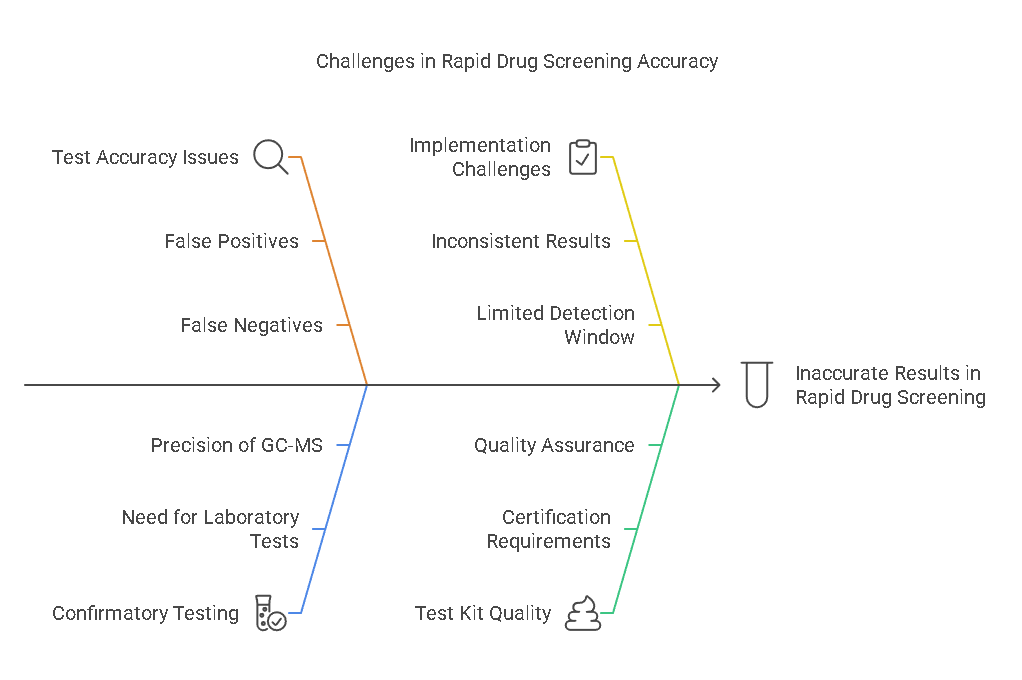
While rapid drug tests offer numerous benefits in terms of convenience and speed, they are not without challenges. The accuracy of the test results is a critical factor to consider when implementing rapid drug screening in any setting.
Accuracy of Rapid Drug Tests
- False Positives and False Negatives: Rapid drug tests are generally accurate, but they can still produce false positives or false negatives. False positives occur when the test incorrectly indicates the presence of a drug, while false negatives happen when the test fails to detect a drug that is present.
- Confirmatory Testing: If a rapid test produces a positive result, it is usually followed by more specific confirmatory testing in a laboratory to ensure the results are correct. Confirmatory tests like GC-MS (Gas Chromatography-Mass Spectrometry) are more precise and can differentiate between drugs with similar chemical structures.
Common Implementation Challenges
- Inconsistent Results: Variability in results can occur depending on factors like user error (incorrect test administration), the quality of test kits, or improper sample collection.
- Limited Detection Window: Rapid tests typically have a shorter detection window compared to traditional lab-based tests, meaning they may only detect recent drug use. For example, urine tests may only detect drug use from the past 1–3 days, while hair tests can detect drug use from several months ago.
- Ensuring Test Reliability: Ensuring that the rapid drug test is reliable and accurate requires the use of certified testing kits. It is essential that employers, healthcare professionals, and law enforcement agencies invest in certified, high-quality kits to avoid errors and ensure valid results.
Comparison of Different Types of Rapid Drug Tests
The following table provides a comparison of the various types of rapid drug tests, highlighting their key features, pros, and cons.
| Type of Test | Detection Window | Ease of Use | Common Applications | Pros | Cons |
|---|---|---|---|---|---|
| Urine Testing | 1–3 days (for most drugs) | Moderate | Pre-employment, random testing, post-incident | Affordable, reliable for recent use detection | May require privacy, can be invasive |
| Saliva Testing | 1–2 days | Easy | Roadside checks, random testing, workplace | Non-invasive, quick results, easy collection | Short detection window, lower accuracy |
| Hair Testing | 1–3 months | Difficult | Employment, long-term substance abuse tracking | Can detect past drug use over a long period | High cost, not ideal for recent drug use |
| Blood Testing | Hours to a few days | Difficult | Medical settings, legal cases | Highly accurate, detects active impairment | Invasive, requires specialized equipment |
Precisehire’s Role in Ensuring Efficient Drug Screening
Precisehire provides efficient and accurate drug testing solutions, supporting employers, healthcare providers, and law enforcement agencies in ensuring compliance, safety, and legal requirements. By offering certified testing kits and professional services, Precisehire ensures that businesses and organizations can maintain reliable and accurate drug screening processes.
Legal Aspects of Rapid Drug Screening
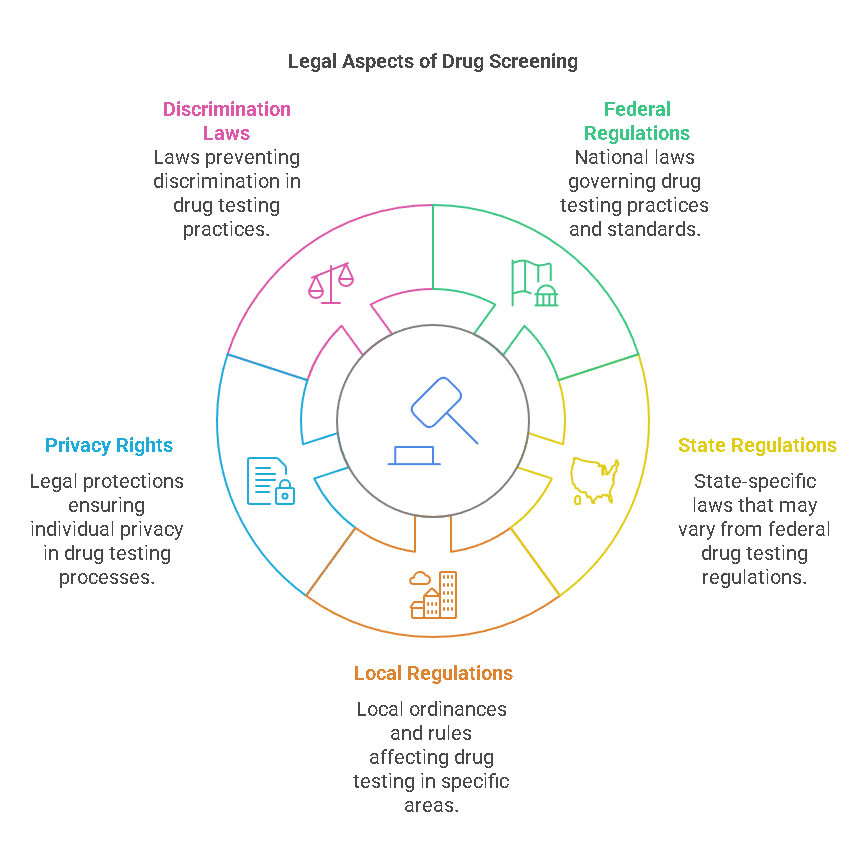
Rapid drug screening plays an important role in maintaining safety and compliance in many industries. However, the legal landscape surrounding drug testing can be complex, as both employers and employees must navigate various federal, state, and local regulations when conducting drug tests. It’s crucial for businesses, healthcare providers, and law enforcement agencies to understand the legal aspects of drug testing to avoid potential violations of privacy rights, discrimination policies, or other legal complications.
Federal Regulations on Drug Testing
At the federal level, drug testing regulations are primarily governed by the Drug-Free Workplace Act of 1988. This law mandates that federal contractors and grant recipients maintain a drug-free workplace, which often involves implementing drug testing programs. The U.S. Department of Transportation (DOT) also has specific regulations for drug testing, particularly in industries like transportation and aviation.
Federal regulations on drug testing typically focus on ensuring that employees are not impaired while performing safety-sensitive duties. For example, DOT regulations require drug testing for employees in safety-sensitive positions, such as truck drivers, pilots, and train operators.
While these regulations are comprehensive, they leave room for flexibility in terms of the types of drug tests conducted. Rapid drug screenings can meet these regulatory requirements as long as the tests are conducted using certified testing methods and the results are accurate.
State and Local Regulations
In addition to federal regulations, many states have specific drug testing laws. These laws can vary widely, so employers and healthcare providers must ensure they are familiar with their state and local regulations regarding drug testing. For example, some states have medical marijuana laws, which may impact how employers can handle drug test results for employees who have legally obtained medical marijuana prescriptions.
Some states require that employers notify employees when a drug test will be administered, and others may limit the circumstances under which drug tests can be performed (e.g., random drug testing may be restricted in certain states). Additionally, certain states may have mandatory drug testing programs for industries such as healthcare or transportation.
Privacy Rights and Discrimination Laws
The legal framework surrounding drug testing also includes protections against invasion of privacy and discrimination. The Americans with Disabilities Act (ADA), for example, prohibits employers from discriminating against employees based on disability, which could include drug or alcohol addiction. While an employer has the right to test employees for drugs, they must ensure that they are not violating employee rights in the process.
Employers must also be careful not to discriminate against employees based on their drug test results. If a test reveals that an employee has used illegal substances, the employer may take action based on the results, but they must ensure that their actions are consistent with company policies and local laws. Employees have the right to challenge positive test results, especially if the test was conducted improperly or the results were inaccurate.
Frequently Asked Questions (FAQs)
How Accurate Are Rapid Drug Tests Compared to Lab Tests?
Rapid drug tests are generally less accurate than lab tests, primarily due to their quick results and lower detection sensitivity. While rapid tests provide results in minutes, they may produce false positives or false negatives. For instance, a rapid test may incorrectly indicate the presence of a drug, or it may fail to detect certain substances.
If a rapid drug test yields a positive result, it is typically followed by a confirmatory lab test (e.g., GC-MS) to ensure the accuracy of the results. Lab tests are considered the gold standard and are more precise in detecting drug use.
Can Rapid Drug Screenings Be Used for Pre-Employment Drug Testing?
Yes, rapid drug screenings are commonly used for pre-employment drug testing. Employers may use rapid drug tests to quickly assess potential hires before offering employment. The speed of rapid testing allows employers to expedite the hiring process, making it an appealing option.
However, if a rapid drug screen produces a positive result, the employer may need to request a more thorough lab test to confirm the findings. This is important to ensure that the candidate’s test results are accurate before making a final hiring decision.
What Substances Can Rapid Drug Screening Detect?
Rapid drug tests can detect a wide range of substances, including:
- Cannabis (Marijuana)
- Cocaine
- Opiates (e.g., heroin, morphine)
- Methamphetamine
- Phencyclidine (PCP)
- Benzodiazepines
- Alcohol (through breathalyzer tests)
Most rapid drug tests can detect multiple substances at once, which makes them versatile and cost-effective. However, the number of substances detected can vary depending on the specific test used.
How Long Do the Results from a Rapid Drug Screen Take?
One of the key benefits of rapid drug screening is the speed at which results are available. In many cases, results can be obtained within 5 to 15 minutes of administering the test. This quick turnaround time is particularly valuable in workplaces and law enforcement settings, where immediate decisions need to be made.
Are Rapid Drug Tests Valid in All States for Legal Purposes?
Rapid drug tests are valid in most states for legal purposes, provided they are conducted in accordance with local, state, and federal regulations. However, the specific rules and regulations governing drug testing can vary by state, and certain substances (e.g., medical marijuana) may not be treated the same way in all locations.
It is important for employers, healthcare providers, and law enforcement agencies to familiarize themselves with the laws in their respective states to ensure compliance. In some cases, a confirmatory lab test may be required to verify the results of a rapid drug test, especially if the test is being used for legal or employment purposes.
Conclusion
Rapid drug screening offers significant advantages in terms of speed, convenience, and efficiency. Whether in the workplace, healthcare facilities, or law enforcement settings, rapid tests help ensure safety and compliance with regulations. These tests are an essential tool for employers, healthcare providers, and law enforcement officers who need to make quick, informed decisions.
However, it is crucial to remember that while rapid drug tests provide quick results, they may not always be as accurate as traditional lab-based tests. The risk of false positives or false negatives exists, which is why confirmatory testing is often required in certain situations.
By adhering to proper legal protocols and utilizing certified testing methods, organizations can ensure that their rapid drug screening processes are both accurate and compliant with regulations. Precisehire offers solutions for businesses looking to streamline their drug testing processes, ensuring they are both efficient and legally compliant, ultimately contributing to safer and more reliable workplace environments.
